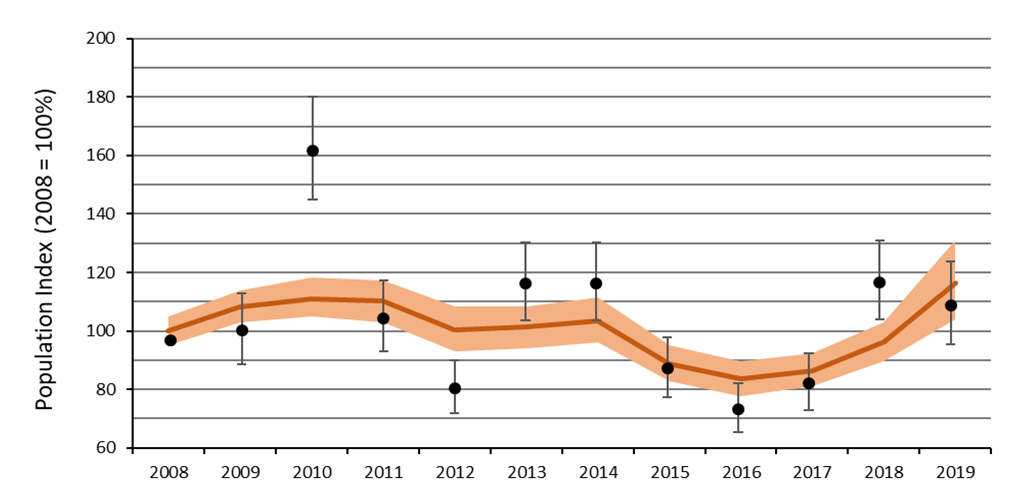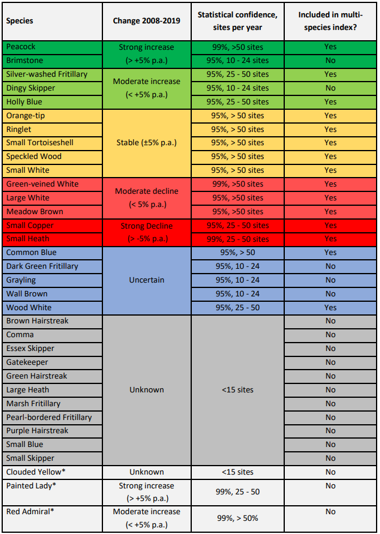| Current status | 2022 |  |
| Short term status | 2018 - 2022 |  |
| Long term status | 2012 - 2022 |  |
Click on the charts below in order to see the full resolution versions.
Butterfly populations are sensitive to changes in climate, land-use and agricultural practices at small to moderate spatial and temporal scales, and are being monitored nationally across 22 countries in Europe. Funded by the European Environmental Agency, the European Grassland Butterfly Indicator, based on data from 17 species monitored across 4,500 sites (ca. 120 in Ireland) as part of national monitoring schemes, shows that between 1990 and 2015 these butterfly populations have declined by 30% (Van Swaay et al. 2016).
This indicator is derived from systematic monitoring schemes coordinated by the Irish Butterfly Monitoring Scheme and the National Biodiversity Data Centre. The scheme has been operating since 2007 with currently over 80 citizen-scientists distributed nationwide, recording butterfly species and abundance using a fixed-width transect count method for 26 weeks between April and October each year. Individual species trends were estimated using the ‘rbms’ package (Schmucki R., Harrower C.A., Dennis E.B. (2022) rbms: Computing generalised abundance indices for butterfly monitoring count data. R package version 1.1.3. https://github.com/RetoSchmucki/rbms). Multispecies index was estimated using international best practice methods developed by Statistics Netherherlands (Multi-Species Indicators, MSI, Soldaat et al., 2017.
Results from multi-species index highlight that there was a moderate decline (-57%) in the population of the 15 most common and widespread species butterflies in 2022 when compared to the baseline year of 2008. Results from the last 10 years (from 2013 to 2022) also show a moderate decline, but this was at a lower rate of 14%. On a per species basis from 2008-2022: no species have increasing populations, 2 have stable populations, 12 are in decline and 6 are too variable to assign a statistically rigorous trend.
The Irish Butterfly Monitoring Scheme is one of 22 monitoring schemes across Europe that form the European Butterfly Monitoring Scheme. An initiative of Butterfly Conservation Europe and the Centre for Ecology & Hydrology (UK) the partnership brings together data from 10,816 transects walked by 100,000 citizen scientist from 22 different countries. This allows pan-European butterfly trends to be detected and provides the data to enable the European Grassland Butterfly Indicator to be generated. The European Grassland Butterfly Indictor 1990-2020 shows that Europe has lost 36% of its grassland butterfly populations since 1990. The European Grassland Butterfly Indicator has been identified as one of the indicators of progress for the proposed EU Nature Restoration Law. This will greatly increase the importance and value of maintaining and extending butterfly monitoring in Ireland.
More information on the Irish Butterfly Monitoring Scheme can be found here:
https://biodiversityireland.ie/surveys/butterfly-monitoring-scheme/
References:
Dennis, E.B., Freeman, S.N., Brereton, T. and Roy, D.B., 2013. Indexing butterfly abundance whilst accounting for missing counts and variability in seasonal pattern. Methods in Ecology and Evolution 4(7): 637-645.
Schmucki, R., Pe'Er, G., Roy, D.B., Stefanescu, C., Van Swaay, C.A., Oliver, T.H., Kuussaari, M., Van Strien, A.J., Ries, L., Settele, J. and Musche, M., 2016. A regionally informed abundance index for supporting integrative analyses across butterfly monitoring schemes. Journal of Applied Ecology, 53(2): 501-510.
Soldaat., L.L., Pannekoek, J., Verweij, R.J.T., van Turnhout, C.A.M., van Strien, A.J. 2017. A Monte Carlo method to account for sampling error in multi-species indicators. Ecological Indicators 81: 340-347.
Van Swaay, C. et al. 2015. The European Grassland Butterfly Indicator: 1990–2013. European Environmental Agency Technical Report, available from: http://nora.nerc.ac.uk/511714/


